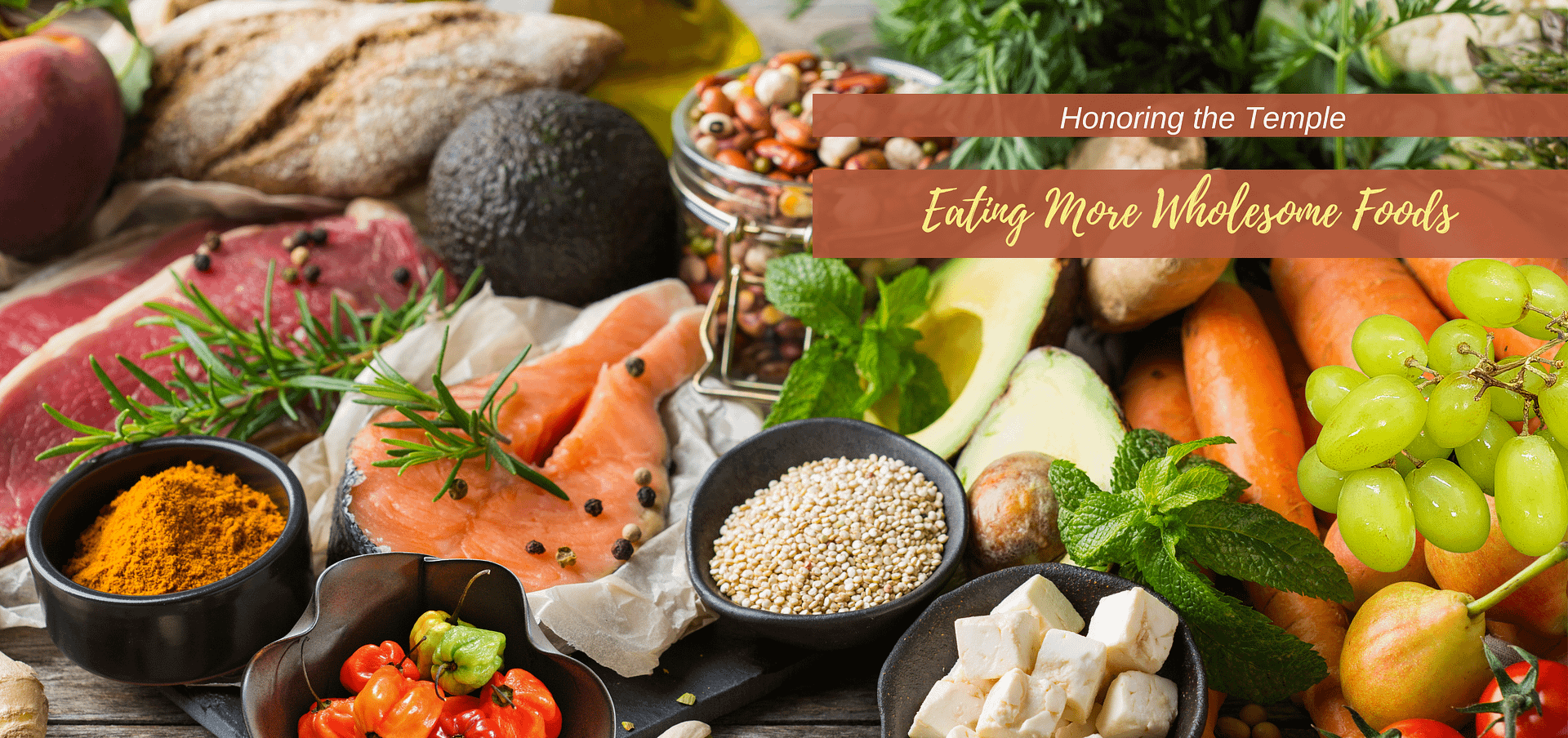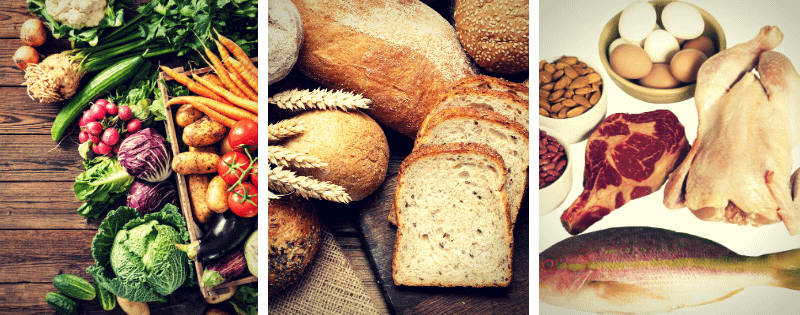
Honoring the Temple and Eating More Wholesome Foods
The key to consuming more wholesome foods is being more conscious of how we shop and prepare them. Whole or wholesome foods are unprocessed and unrefined. They are also produced without the use of any chemicals, pesticides or fertilizers. So in essence, this type of diet ensures that we are eating meat and produce in a state which is most beneficial to the body.
Yet while it is imperative for us to honor the temple by eating more wholesome foods; we also have to remember that Scripture tells us that it is not what goes in the mouth that defiles the temple, but what comes out (Matthew 15:11). Therefore, as we adopt a more wholesome diet, it is wise to also be mindful of the words we speak — the words we speak about ourselves, our lives and even other people. This is not the easiest task and does require us to be patient with ourselves. In fact, if you’ve taken on this journey any at all, you know it certainly involves some repentance 🙂
A Break-Down of a Wholesome Foods Diet
A wholesome foods diet also allows our digestive and metabolic systems to function more efficiently, enabling the proper absorption of nutrients and a more energized and fueled body with the ability to properly eliminate wastes. A complete, wholesome foods diet includes a well-balanced variety of all the required groups—namely proteins, carbohydrates, fruits and vegetables, as well as fats.

Protein
Protein is an essential nutrient. In fact, every cell, organ and tissue in the body contains this very important substance. When it comes to whole-foods, meat and eggs, are however not the only protein sources. We can also obtain this nutrient from plant-based protein sources.
There are basically two (2) protein sources: complete and incomplete protein.
A complete protein is a protein source which contains an acceptable proportion of all of the nine (9) essential amino acids the body needs to build cells, as it is not able to make it on its own.
Complete protein sources include animal derived protein, such as meats, fish, poultry, as well as milk and eggs.
Incomplete proteins are protein sources which are lacking in one or more of the nine (9) essential amino acids.
Examples of incomplete protein sources include plant-based protein, like nuts, whole grains and beans.
However, two incomplete proteins that compensate for each others’ amino acid inadequacies are often referred to as complementary proteins. The two incomplete proteins combined make up a complete protein.
According to the Utah Department of Health, complementary proteins do not have to be eaten at the same time. Basically, as long as they are eaten within the same day, they are still considered complementary.
Examples of complementary protein sources include:
- Brown rice and beans
- Peanut butter sandwich on whole grain bread
- Whole grain cereal with milk
- Cheese and whole grain macaroni
- Yogurt with ground flaxseeds
- Spinach salad with walnuts
5.5 ounces of protein and 3 cups of dairy are the daily amounts that the USDA recommends for the average adult.
Fruit and Vegetables
Fruits and vegetables contain many essential vitamins, minerals and fiber. As a result, according to the USDA, a diet rich in these two food groups may aid in maintaining healthy stress levels, lowering caloric intake and even averting certain diseases.
Based on U.S.D.A. requirements, the daily recommended intake for the average adult is:
Fruits – 2 cups for men and 1.5 – 2 cups for women
Vegetables – 3 cups for men and 2.5 cups for women
Note: Determined by sex, age and the amount of physical activity performed each day.
Carbohydrates
The cells in our body require carbohydrates for them to function properly. This is because carbohydrates are the primary source of energy for the body. Besides that, glucose, a component of carbohydrates, is the main nutrient that the brain uses for fuel.
Both simple and complex carbohydrates convert to glucose.
Simple carbohydrates are found in processed sugars such as sodas and candy. However, they also occur naturally in fruits and milk. Complex carbohydrates on the other hand, are found in veggies, peas and whole grains.
Whole Grains
When it comes to grains, we are frequently told to opt for whole grains over refined grains. According to the Whole Grains Council, “eating whole grains instead of refined grains can lower the risk of many chronic diseases.”
Whole grains can be consumed in the form of pasta, rice, breads and cereals to obtain the benefits of these healthy carbohydrates.
Fats
Fats provide the body with a concentrated source of energy. Healthy fat sources (good fats) help to ensure the proper functioning of the immune system. They are also responsible for the health of the cell membranes and help to maintain a good hormone balance.
Healthy Fat Sources
Monounsaturated Fats
Monounsaturated fats are in a variety of whole-foods; including nuts and high-fat fruits. Essentially, these healthy fat sources lower LDL cholesterol (known as the bad cholesterol) while increasing HDL (good) cholesterol.
Sources: walnuts, almonds, pistachios, avocado, olive oil.
Polyunsaturated Fats
Polyunsaturated fats are mainly in plant-based oils and fish sources.
Omega-3 fatty acids – Omega-3 fatty acids are present in fish oil and in plant-based sources. Studies show that omega-3 fatty acids may help lower bad cholesterol and increase good cholesterol. It may also lower the risk of coronary heart disease. Furthermore, the omega-3 fatty acids in fish oil are docosahexaenoic acid (DHA) and eicosapentaenoic acid (EPA). Alpha-linolenic acid (ALA) is another omega-3 fatty acid which is present in some plant-based sources such as flaxseeds, walnuts, spinach, kale and soybean. The body converts ALA to DHA and EPA.
Sources: Sardines, salmon, flax seeds and walnuts.
Omega-6 fatty acids – Omega-6 fatty acids are found primarily in plant-based sources. They may also help to lower LDL (bad) cholesterol and prevent heart disease.
Sources: Soybean oil, corn oil and safflower oil.
The daily allowance of oil for the average adult is 6 teaspoons per day, according to the USDA.
Finally, the following is another resource you may find helpful:
LocalHarvest.org – A directory of family farms that provide fresh meat and produce in your area.
Check-out any of my publications on meditation and stillness below:
Shop the Stillness & Me-time Collection
Check-out these items in our Zazzle Store
Have you read the latest issue of Stillness & Me-time Magazine?
-

Stillness and Me-Time Magazine – Volume I, Issue 2
Free Download -

Stillness and Me-Time Magazine – Volume III (in-Print)
Learn More on Amazon -

Stillness and Me-Time Magazine – Volume II (in-Print)
Learn More on Amazon -

Stillness and Me-Time Magazine (in-Print)
Learn More on Amazon -

Stillness and Me-Time Magazine
$7.00 Add to cart -

Stillness and Me-Time Magazine – Volume II
$7.00 Add to cart -

Stillness and Me-Time Magazine – Volume III
$7.00 Add to cart




